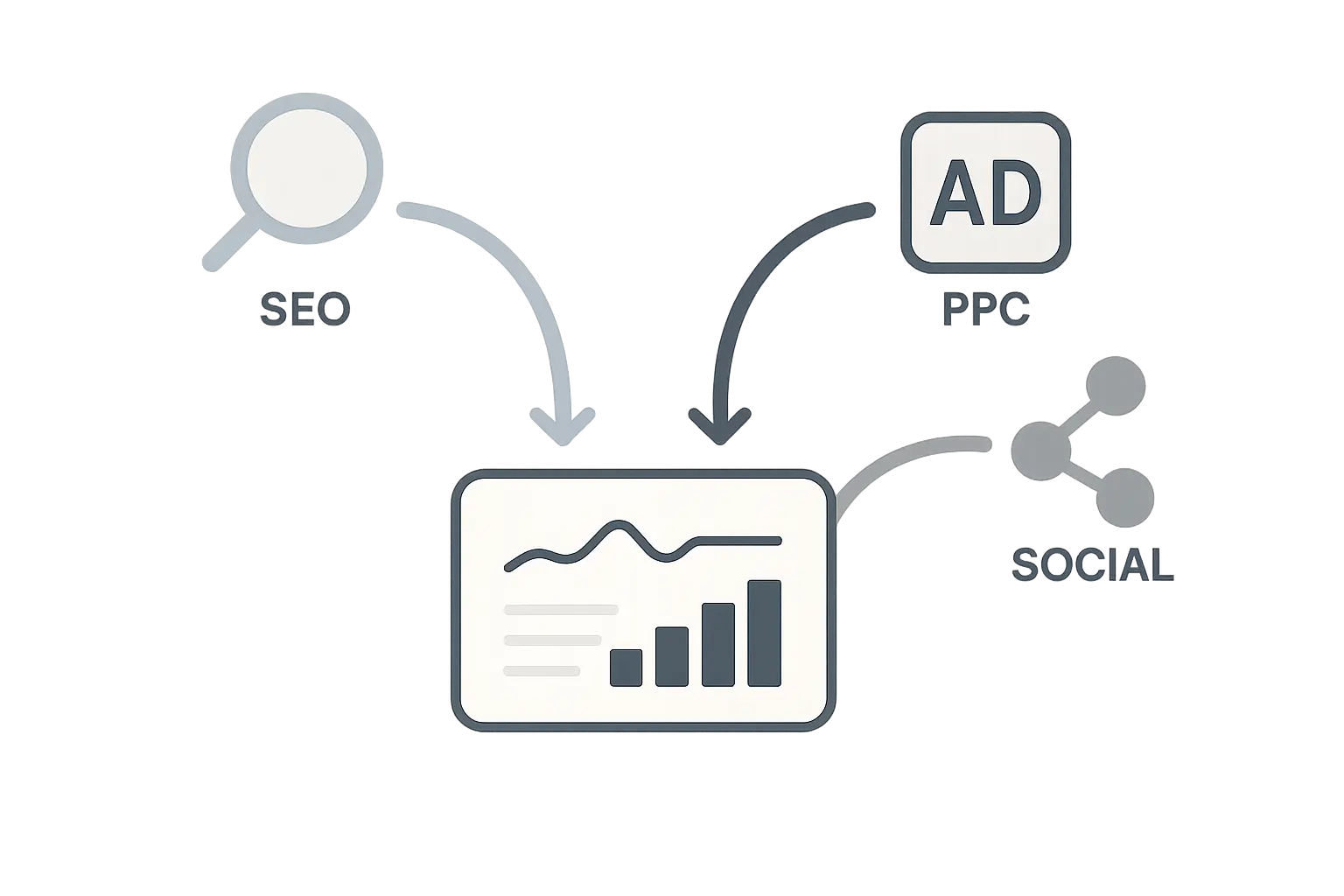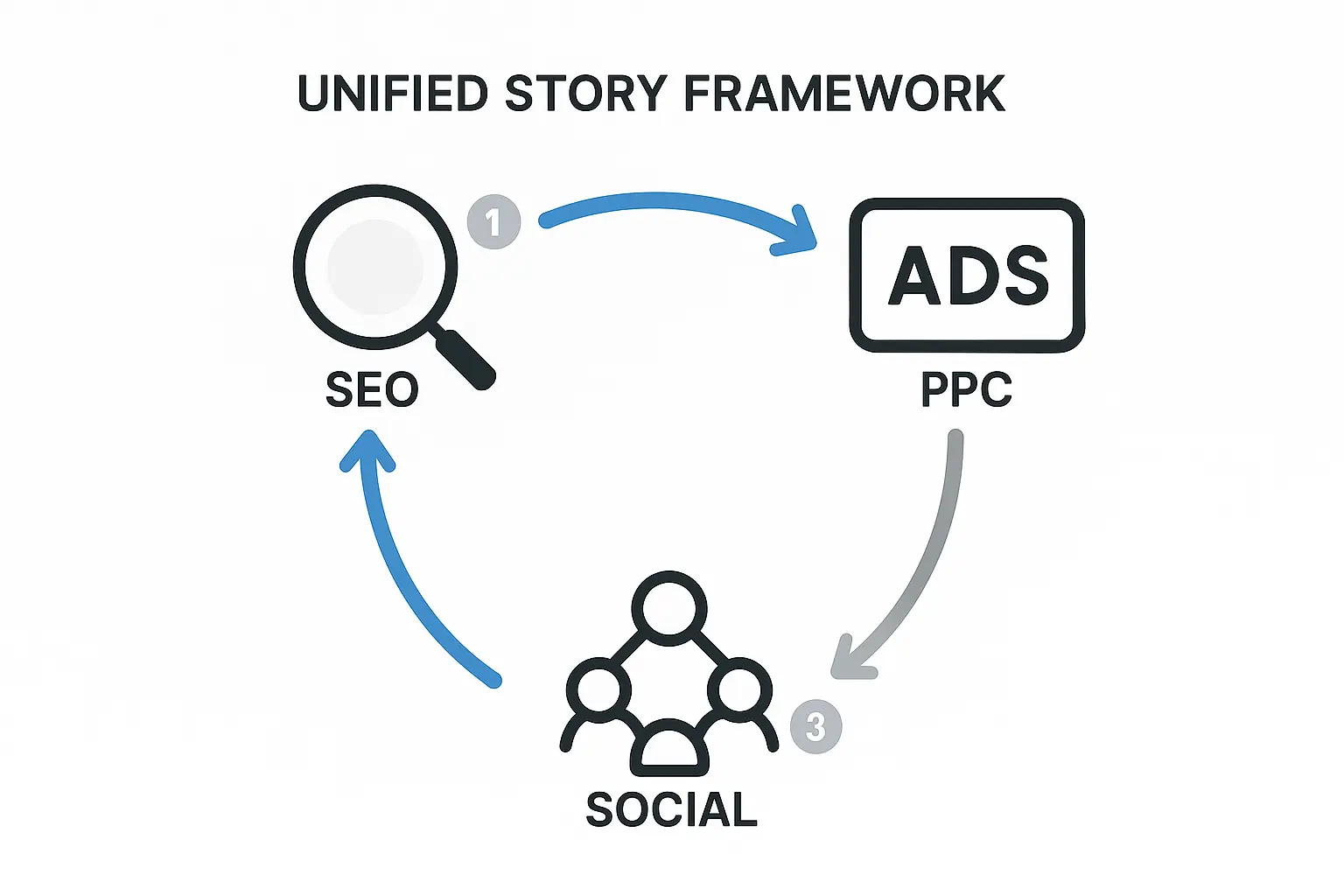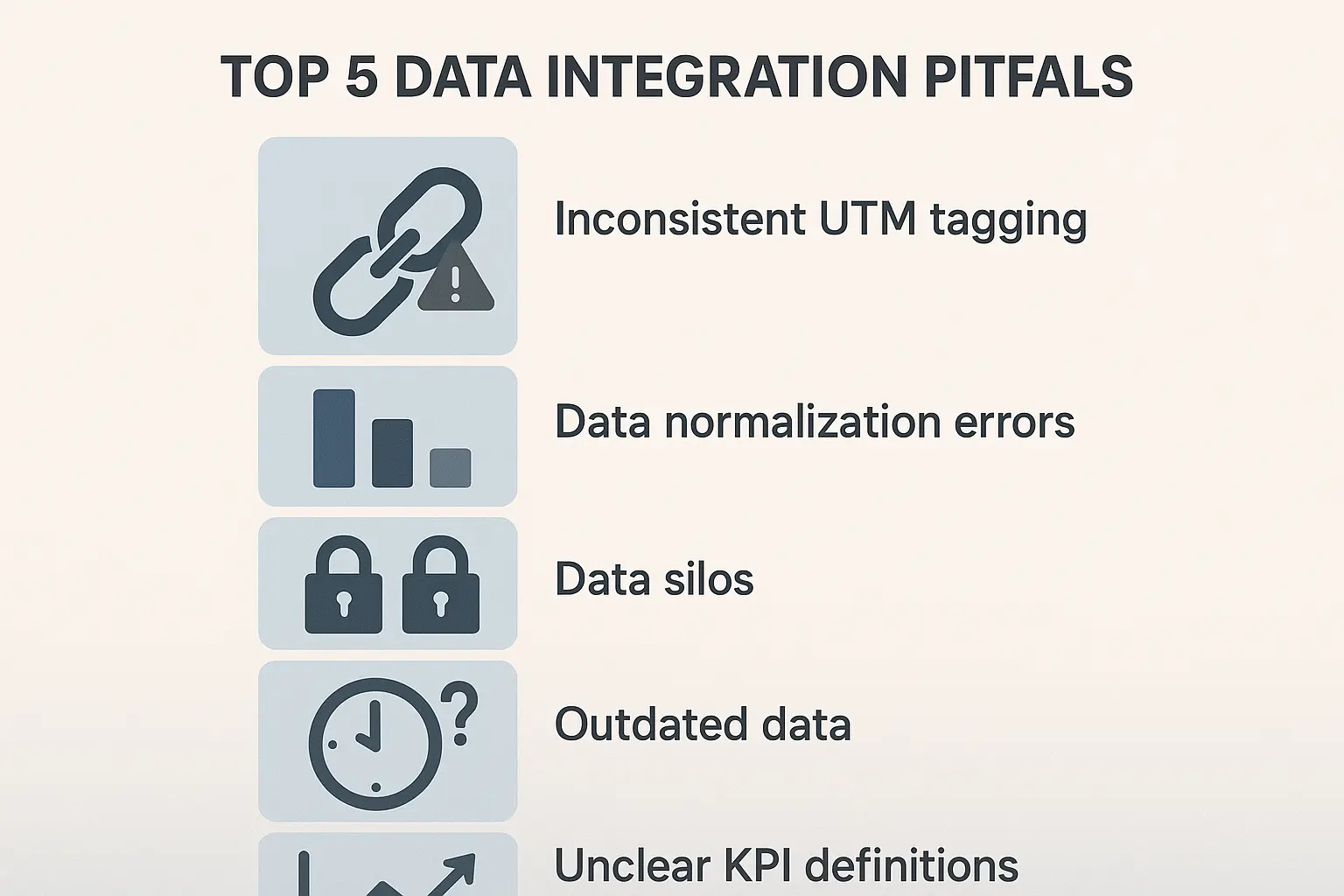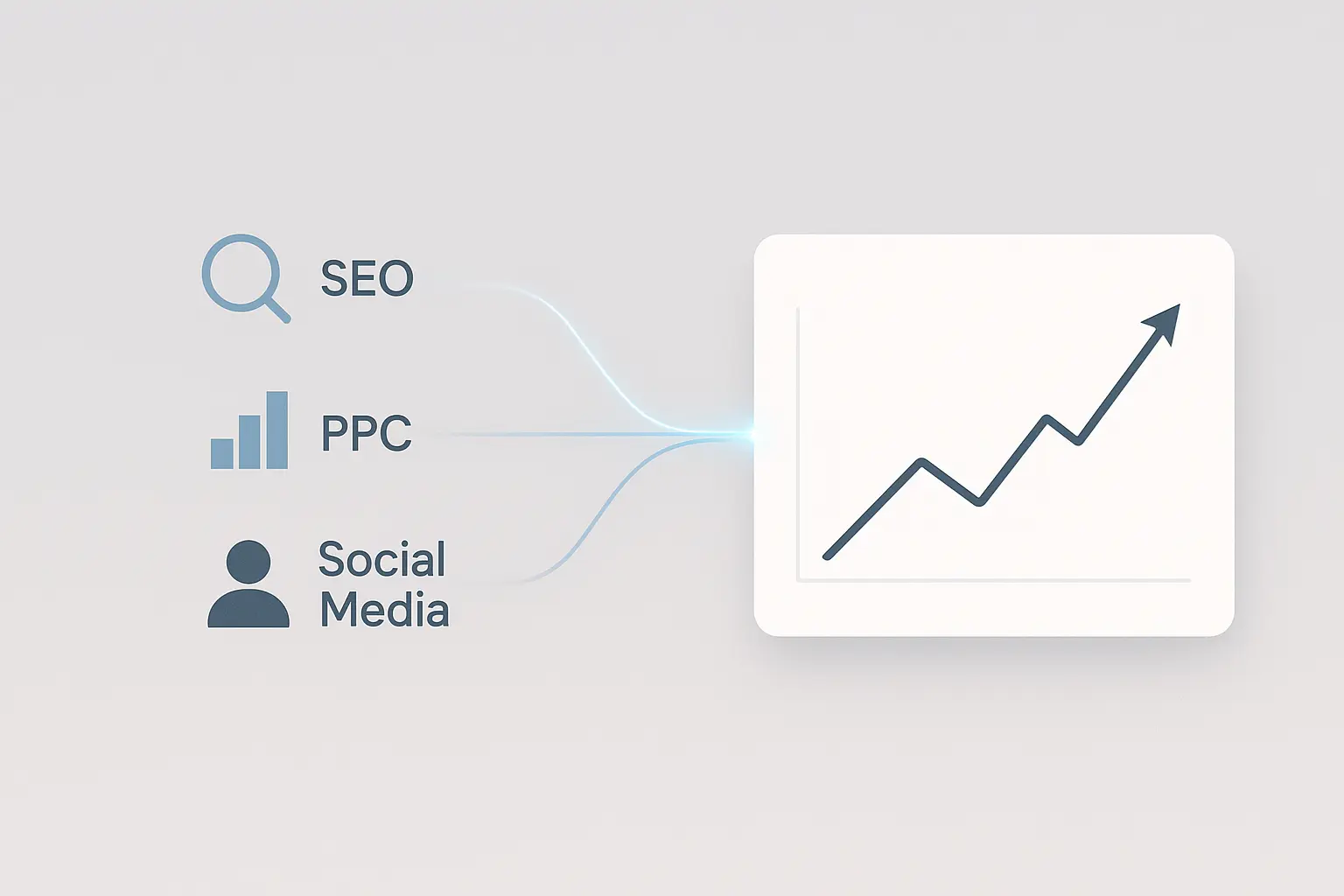Beyond Silos: The Agency’s Guide to a Unified Marketing Dashboard for SEO, PPC & Social
Ever have that Monday morning feeling? You’re staring at three different browser tabs—Google Analytics, a PPC ads manager, and a social media platform.
Your mission, should you choose to accept it, is to manually copy-paste metrics into a spreadsheet, trying to weave a coherent story for a client who just wants to know one thing: “Is our marketing working?”
Sound familiar? You’re not alone. The struggle to connect the dots between different marketing channels is one of the biggest challenges modern agencies face. While each platform tells a piece of the story, your clients need to see the whole picture. They don’t think in terms of “organic traffic” versus “ad clicks”; they think in terms of customers.
The truth is, siloed data doesn’t just create reporting headaches—it actively limits your agency’s ability to deliver game-changing results.
The Hidden Cost of Disconnected Data
In marketing, we call these disconnected platforms “data silos.” Each one—your SEO tools, your PPC manager, your social analytics—is a treasure chest of valuable information. The problem is that these chests are locked, and they don’t have keys to each other.
This isn’t just a minor inconvenience; it’s a major strategic blind spot. Research shows that nearly half (47%) of marketers say data silos are their single biggest challenge in creating a cohesive customer journey. When your data is fragmented, you can’t see how a customer really interacts with a brand.
Did a potential customer discover your client’s product through a viral Instagram Reel, Google it a week later, and then finally convert through a targeted PPC ad? Without a unified view, you’d see only three separate, unrelated events. You miss the most important part of the story: how they worked together.
This leads to:
-
Wasted Ad Spend: You might turn off a “low-performing” social campaign, not realizing it’s the primary driver of brand-aware searches that convert through SEO and PPC.
-
Missed Opportunities: You can’t see that a high-performing organic blog post is driving search terms that would be goldmines for a new PPC campaign.
-
A Frustrating Client Experience: A staggering 54% of marketers admit that disconnected data leads to a disjointed customer experience. Clients see the cracks, even if they can’t name them.
The bottom line: when you report in silos, you strategize in silos. And in today’s interconnected world, that’s a recipe for falling behind.
The Omnichannel Shift: Why Your Clients Expect a Single Story
Think about the last time you made a significant purchase. You probably didn’t see one ad and immediately buy. Maybe you saw a post on social media, read a few reviews you found on Google, watched a YouTube video, and then clicked a shopping ad.
That’s the modern customer journey—not a straight line, but a web.
This is why a unified dashboard is no longer a “nice-to-have.” It’s the only way to accurately reflect reality. When you integrate data from SEO, PPC, and social media, you stop reporting on channel metrics and start reporting on customer behavior. You move from answering, “How did our Facebook ad do?” to “How are our customers finding us, and what makes them convert?”
This shift in perspective is what separates a good agency from a true growth partner. It all starts with seeing your data in one place.
Connecting the Dots: What a Unified Dashboard Reveals
When you break down the walls between your data, you uncover powerful strategic insights that were previously invisible. You can finally trace the cause-and-effect relationships between your marketing efforts.
How SEO and PPC Become a Power Couple
Separately, SEO and PPC are effective. Together, they’re unstoppable. A unified dashboard makes their synergy obvious.
-
PPC Data Fuels SEO Strategy: See a PPC keyword converting exceptionally well? That’s a clear signal to double down on creating SEO content around that topic. A dashboard immediately flags this opportunity, allowing you to build long-term organic authority based on proven, paid insights. This is where services like white-label content planning can turn those insights into action.
-
SEO Data Reduces PPC Costs: Discover you’re ranking on page one for a high-intent keyword? You can strategically lower your PPC bid for that same term, reallocating budget to keywords you don’t yet own organically. This simple move can drastically improve your client’s return on ad spend (ROAS).
Weaving Social Signals into Your Search Strategy
Social media is often treated as a separate “brand awareness” channel, but its impact on search is massive. In fact, research shows that 60% of consumers now use social media platforms to research products.
A unified dashboard is key to harnessing this behavior.
-
Identify Emerging Trends: Did a particular topic or product suddenly go viral on TikTok or Instagram for your client? A unified dashboard reveals a corresponding spike in branded and non-branded search traffic. This is a real-time indicator to launch new SEO and PPC campaigns to capture that demand before competitors do.
-
Amplify Content Performance: You can track how a social campaign promoting a new blog post directly impacts its organic rankings, referral traffic, and even the backlinks it earns. This proves the full ROI of your social efforts beyond just likes and shares.
From Top-Funnel Awareness to Bottom-Funnel Conversion
The classic marketing funnel isn’t just a theory; it’s a journey you can visualize with a unified dashboard. You can finally show your clients the complete story of how a customer moves from initial awareness to final purchase.
-
Top of Funnel (Awareness): Social media campaigns introduce the brand to a wide audience.
-
Middle of Funnel (Consideration): SEO content like blog posts and guides answers their questions and builds trust as they research.
-
Bottom of Funnel (Conversion): Targeted PPC ads, especially retargeting, bring them back to the site to make a purchase.
A unified dashboard connects these stages, attributing value to each touchpoint and proving how your integrated strategy works as a single, powerful growth engine.

The Power of Automation and White-Labeling
If unifying this data sounds like even more manual work, think again. The goal isn’t to create a more complicated spreadsheet; it’s to automate the entire process.
It’s no surprise that nearly half of all businesses (49%) are now using some form of marketing automation. Automated dashboards pull data from all your sources in real-time, eliminating human error and freeing your team from the drudgery of data entry.
This frees up your most valuable resource—your team’s brainpower—to focus on what truly matters: analyzing the data, finding strategic insights, and planning the next big move for your client.
And the final piece of the puzzle? White-labeling.
An automated, unified dashboard should look and feel like it came directly from your agency. When you deliver these powerful, cross-channel insights under your own brand, you reinforce your position as the central strategic partner. You’re not just managing channels; you’re orchestrating the entire growth strategy. This is the essence of modern white-label SEO services—combining powerful back-end technology with your agency’s front-end expertise.

Frequently Asked Questions (FAQ)
What is an omnichannel marketing dashboard?
An omnichannel marketing dashboard is a single interface that consolidates and visualizes performance data from multiple marketing channels, such as SEO, PPC, social media, and email. Its purpose is to provide a holistic view of the customer journey and overall marketing performance, rather than looking at each channel in isolation.
Why can’t I just use Google Analytics 4?
While GA4 is a powerful tool for understanding website behavior, it doesn’t always integrate seamlessly with the native data from platforms like Facebook Ads, LinkedIn, or TikTok. A dedicated omnichannel dashboard pulls data directly via APIs from each source, providing more accurate, granular, and reliable metrics (like ad spend and impressions) that GA4 might miss or misattribute.
What are the most important cross-channel metrics to track?
Beyond channel-specific metrics, focus on:
-
Customer Acquisition Cost (CAC): The total marketing spend across all channels divided by the number of new customers.
-
Assisted Conversions: Shows which channels played a role in the conversion path, even if they weren’t the final click.
-
Conversion Rate by Journey: Compare conversion rates for customers who interact with one channel versus multiple channels.
-
Customer Lifetime Value (CLV): Tracks the total value of a customer acquired through different paths.
How does this help me prove ROI to my clients?
A unified dashboard proves ROI by connecting top-funnel activities (like social media engagement) to bottom-funnel results (like sales from PPC). It allows you to tell a complete, data-backed story, showing how every dollar invested in each channel contributes to the client’s ultimate business goals, not just vanity metrics.
Your Next Step: From Data Chaos to Strategic Clarity
Stop juggling spreadsheets and fighting with data silos. The future of agency growth lies in telling a single, unified story backed by comprehensive, cross-channel data. By integrating your SEO, PPC, and social efforts into one automated, white-label dashboard, you can move from a reactive reporter of metrics to a proactive driver of strategy.
You’ll save time, uncover more powerful insights, and demonstrate your value to clients in a way that’s impossible when your data lives on separate islands.
Ready to build your strategy on a rock-solid foundation? It all begins with your client’s website. Starting with the insights from a comprehensive technical SEO audit is the first step toward building a truly integrated digital marketing engine.


